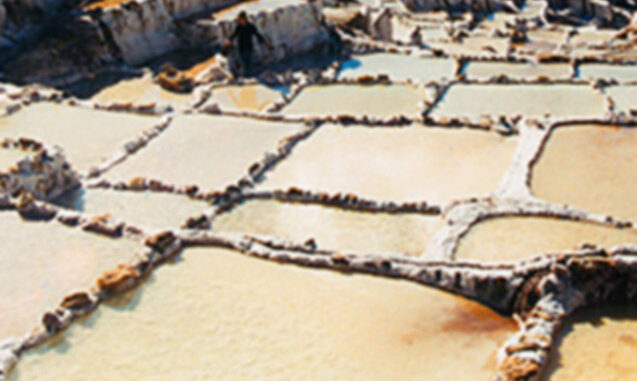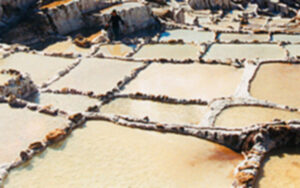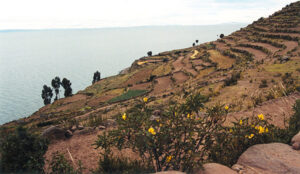

Richard Brommer
Maras salt pans
In the United States in the twenty-first century, we have come to expect frequent change in nearly every aspect of our lives. Fashion and technology are constantly changing, and the appliances we buy get restyled or improved every year. We experiment with the way we use our land and grow our food, and we shop at the newest grocery stores in our neighborhoods.
Some societies don’t change what already works for them. The indigenous people of Peru, Ecuador, and Bolivia maintain traditional practices that have been successful for hundreds of years. The ways in which they use and work their land, harvest their crops, make their clothes, do their laundry, and shop for food and other goods have almost never changed. In fact, in places where some of these traditional ways have fallen into disuse, people are working to restore them because they were such successful solutions to age-old problems.
How would you grow crops on a mountain? The Incas came up with a solution that still works. They engineered terraces up mountain slopes, which created flat fields. This allowed them to improve the soil, because it didn’t wash away when it rained. In locations where these terraces have been neglected in recent years, local farmers are working with volunteers to fix the stone walls and irrigation canals, enabling a return to traditional methods of soil improvement.

Richard Brommer
Crops are still grown on the terraces on Taquile Island at Lake Titicaca.
Even before Inca times, the people of Maras in Peru built pools for salt farming that are still in use today. The salt water that flows from a natural spring at the top of the mountain is directed into the terraces and left to evaporate. Over the course of a month, several inches of salt solidify on the terrace floor. The salt miners hammer the solid salt to loosen it up, bag it, and sell it at regional markets.
The people of Bolivia’s Beni region are also bringing back their ancestors’ system to combat flood and drought. They are building camellones—raised earth banks surrounded by canals— which keep crops from being washed away by floods. During the dry season, water in the canals irrigates the crops on the earth platforms.
Share What You Know:
Table salt from Andean salt pools is available for sale at specialty shops and online. If you are able to purchase a jar of this special salt, bring it to class for everyone to taste on some snacks.